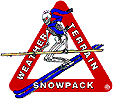Mountain Snowpack 1 Course (also Module 5 of Level 1)
Here is the complete description for this course. This is a mirror of what is posted as part of the course inside dokeos. All of the instructional details are included - the narrative description, topics, specific objectives, outline, assessment information, resources available, and course material information.
Since this course is presented online at your own pace and has assessments we can guarantee that nothing will be left out. There are no time constraints, no outside factors that may require shortening the course or omitting anything, and no way to complete the course without passing the numerous short assessments. We can guarantee that everything posted below will be exactly as stated here.
Course description
This course/module is the first of two on the mountain snowpack in the Level 1 Avalanche Class![]() curriculum. The Level 1 course began around 2006 and was developed and supported by AlpenPro
curriculum. The Level 1 course began around 2006 and was developed and supported by AlpenPro![]() and is offered here in the Avalanche Institute
and is offered here in the Avalanche Institute![]() . The new, improved and updated version of this Snowpack 1 course/module was released in March of 2021.
. The new, improved and updated version of this Snowpack 1 course/module was released in March of 2021.
The only pre-requisite for this course/module is Module 1 - Preliminary (or Background) Material. Which is included if you are taking this course on its own. In the Level 1 course this module is a prerequisite for the first field day, the Snowpack 2 module, and some advanced modules beyond Level 1.
The module covers the basic nature and features of the mountain (inclined) snowpack, introduces some of the properties of snow, and describes basic non-snowpit observations to be made in order to construct a "big picture" of snowpack stability. The emphasis is on basic and applied topics with a little background theory to provide insight and understanding and to build a basis for further studies.
Topics
The first short section introduces the course and workbook.
This main course/module covers three general topics:
- Introduction to the Mountain Snowpack
- Properties and Behaviors of Snow
- Basic Observations
The concluding section wraps up the course and encourages plans for further learning.
Each of these is broken down further into sub-topics within the course, the Outline on this page shows more detail.
Objectives
- Describe the nature of a mountain snowpack
- Characterize maritime vs. continental snowpacks
- Differentiate between new snow weaknesses and persistent weaknesses
- Explain what surface hoar is, the conditions it forms under, and how to manage its risk
- Explain the visco-elastic nature of snow and when it is more viscous or more elastic
- Define creep and glide and explain the difference
- Explain why convexities are often trigger points for slab avalanches
- List snow observations that can be made without a snowpit
- List and describe several “on the go” structure and stability checks
- Appreciate the need for spatial and temporal context
Outline
Welcome, Instructions
Introduction
The Mountain Snowpack
- Layering
- Climate and Snowpack
- Surface Hoar
Properties and Behaviors of Snow
- Gravity on the Snowpack
- Glide
- Viscous vs Elastic Behavior
- Creep
Basic Observations
- General "Big Picture" Observations
- Before the Trailhead
- Observed Avalanches
- Active Tests
- Below the Surface
- Context and Limitations
- Advisories or Bulletins and the "Big Picture"
Wrap-Up
- Review
- Learning More
Assessments
There are quizzes incorporated into this course which allow students to check their understanding of the material. Quizzes may be taken as many times as desired, either to obtain a passing score or just to attempt to ultimately get a perfect score.
All assessments are taken and scored online in this module/course.
Successful completion of this module requires passing all assessments.
Human and technical Resources
This module has complete access to human resources and technical support. There are numerous ways to contact an instructor and to interact with other students. The module has its own forum for questions and discussion, there is a dropbox for sending documents (including messages) to other students in the module and/or an instructor, there is a messaging system accessed from the top of the web interface, and there is always email.
Major web browsers are supported, others - including phones - are not. At least officially. Find a computer and a good place to study without distractions. If you encounter technical problems with Dokeos or with a major browser we will address the problem promptly. If we are unable to we will offer a refund. This does not apply if you are using an unsupported browser or a phone.
We will note that some students have been able to use a phone for our courses or parts of them. It may work. We just will not guarantee that, and if it does not then we will not make much effort at support.
Course material
Most of the materials in this module were created specifically for this course. Some diagrams originated in the AlpenPro workbook used in traditional courses and some come from the Avalanche Center website.
There is a workbook which can be printed in pieces as the student progresses through the course. These contain primarily copies of diagrams and figures used online as well as space for taking any notes. There may be a limited amount of additional material in the workbook which is not presented online. The workbook is provided so that students who print it will have a reference following the course, it supplements the course and is not a stand-alone book.
Links are provided to external resources where appropriate.
There are two short homemade videos which are old and not high quality, but they do successfully get our point across. There are no video lectures, we do not teach using recorded lectures.

 Avalanche Institute Home
Avalanche Institute Home